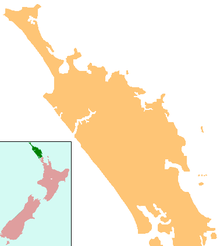RNZF Station Onerahi
|
Whangarei Airport Te Taunga Waka Rererangi o Whangārei | |||||||||||||||
|---|---|---|---|---|---|---|---|---|---|---|---|---|---|---|---|

| |||||||||||||||
 Whangarei Airport, on the Onerahi peninsula, surrounded by Whangarei Harbour
| |||||||||||||||
| Summary | |||||||||||||||
| Airport type | Public | ||||||||||||||
| Operator | Whangarei District Airport | ||||||||||||||
| Location | Whangarei | ||||||||||||||
| Elevation AMSL | 133 ft / 40.5 m | ||||||||||||||
| Coordinates | 35°46′06″S 174°21′54″E / 35.76833°S 174.36500°E | ||||||||||||||
| Website | www.whangareiairport.co.nz | ||||||||||||||
| Map | |||||||||||||||
| Runways | |||||||||||||||
| |||||||||||||||
| Statistics (2009) | |||||||||||||||
| |||||||||||||||
Whangarei Airport (IATA: WRE, ICAO: NZWR) is a small airport 4 nautical miles (7.4 km; 4.6 mi) to the south east of Whangarei city, in the suburb of Onerahi, on the east coast of Northland on the North Island, New Zealand. The airport has a single terminal with two gates.
The first aerodrome in Whangarei was located on Pohe Island, in the upper reaches of Whangarei Harbour. Sir Charles Kingsford Smith’s aircraft, the Southern Cross, landed on Pohe Island in 1928. This airstrip was not of high quality due to it being built on boggy reclaimed land, so a more suitable site was required. Another site was considered, at Kensington Park, but in May 1939 the current site was opened at Onerahi.
With the outbreak of World War II, immediately after the establishment of the airfield, the airport was taken over by the RNZAF to serve as a training base which became RNZAF Station Onerahi. Flight Lieutenant "Lou" Gates became one of the station commanders. Pilots practiced bombing raids on the nearby Matakohe Island and Rat Island. The airport was established with three grass runways. No. 20 Squadron RNZAF was formed there in August 1942 with Hawker Hind biplanes, personnel and aircraft provided from No. 6 (AC) Squadron RNZAF at Milson, Palmerston North. The squadron was disbanded in July 1943 (before being reformed elsewhere later in the war). The station was reduced to two runways (06/24 and 32/14) shortly after the war, and being converted for public use. Some of the old airforce barracks are still present today, having been converted into residential properties.
...
Wikipedia

